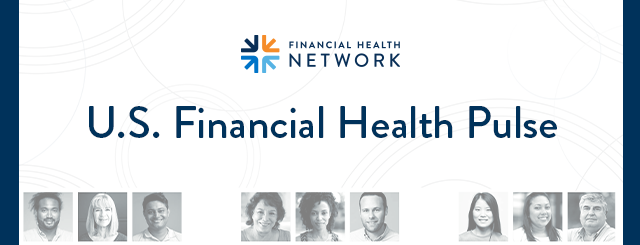The recent open enrollment season means that for many of us, insurance is still top of mind. Other key moments such as the start of a new year, tax season, a new job, or family additions also provide a chance to reflect on insurance throughout the year. According to the recently released U.S. Financial Health Pulse — 2019 Trends Report, only 58% of Americans are confident that their insurance will provide sufficient coverage in the event of an emergency*.
While many households understand the importance of sufficient insurance coverage in building financial resilience, factors such as stagnating wages, policy changes, rising premiums, and decreasing marketplace competition in some states have made it challenging for many people — especially those with low- to moderate-incomes — to access and afford adequate insurance. Previous research done by the Financial Health Network has found that hard-to-understand policies and mixed feelings about insurance companies can make feeling confident about one’s insurance policies challenging as well. Without the necessary safeguards in place, financial shocks — such as unexpected healthcare costs or home repairs — can adversely affect a household’s financial health.
Why insurance is important to financial health
Insurance is crucial in protecting consumers across all income levels against unexpected financial shocks. As one of the Financial Health Network’s eight indicators of financial health, adequate insurance coverage can directly impact a household’s ability to successfully manage the rest of their financial lives — including budgeting expenses, managing credit and debt, and building short-and long-term savings.
Let’s look at health insurance as an example of how lacking appropriate insurance coverage can have serious implications for both physical and financial health. As we found in the 2019 Pulse survey, many Americans face difficult healthcare decisions surrounding cost of care, often foregoing treatment or prescription medications because they can’t afford them (see chart below). Unexpected illness, injury, or even standard treatments can lead to substantial medical debt for those without coverage or with inadequate coverage, compromising one’s ability to stay on top of monthly bills, draining savings, or damaging credit scores. These financial hardships can in turn lead to stress and increased vulnerability: we found that 57% of Americans without health insurance report experiencing moderate to high stress related to their finances — stress which can, in turn, lead to more health problems.

Americans have become less confident that their insurance will provide sufficient coverage in an emergency
According to the 2019 U.S. Financial Health Pulse survey, people in America have become less confident over the past year that the coverage levels of their insurance policies (including life, disability, health, car, homeowners, and renters insurance) will be sufficient in an emergency. This decline in confidence coincides with an increase in the number of people who report having no insurance coverage of any kind since 2018, pointing to a worrisome trend toward heightened vulnerability.
Much of the declining confidence and coverage we observe may be the result of declining rates of health insurance coverage nationwide. According to recent Census estimates, 9.1 percent of people lacked health insurance in early 2019, a 0.4 percentage point increase from early 2018. This drop can be attributed to a number of factors including policy changes to the Affordable Care Act, most notably the repeal of the individual mandate penalty, the approval of Medicaid work requirements, and the final “public charge” rule.
Help promote financial resiliency through adequate insurance coverage
Stakeholders across the financial health ecosystem — including employers, insurance providers, nonprofits, financial coaches, policymakers, and consumers — can help people ensure that their insurance policies will allow them to be resilient in the face of unexpected shocks:
- Employers should consider their benefits offerings. Addressing employees’ questions or concerns about their coverage options, providing guidance during enrollment periods, and collecting employee feedback can help ensure inclusivity. Beyond health insurance, offering life insurance, disability insurance, or even pet insurance could make a significant difference in employees’ financial health.
- Insurance providers can work with clients to ensure that they are prepared for financial shocks. Since peace of mind is one of the main drivers for why people purchase insurance, insurers can strengthen this sense of security — and confidence — by offering more tailored guidance and/or bundled products to meet their coverage needs.
- Non-profit organizations and financial coaches can help clients evaluate their health insurance by factoring in changes to their household situation, income, and healthcare. Spending calculators like this one can help predict annual household healthcare costs, and budgeting platforms like Mint or Albert can help clients track their healthcare costs during the year.
- Policymakers can support innovation in the insurance space that focuses on better reaching and serving consumers, especially those that are financially struggling. They can also adopt a more holistic view of financial health, and foster efforts that seek to understand and cater to the complexity of Americans’ financial lives.
- Consumers should consider where they might be under-insured. Reviewing property and casualty insurance, such as home and auto policies, may reveal gaps in coverage. (Remember: these policies can be adjusted any time throughout the year.) They can also focus on building emergency savings, since together with insurance, having a rainy-day fund set aside can help cushion the shock of unexpected expenses or events.
Insurance is an important component of financial health that should be top-of-mind throughout the year, not just during key moments or milestones. To learn more about how insurance and other factors can impact financial health, read the U.S. Financial Health Report or other thought leadership from our team here: https://finhealthnetwork.org/research/insurance/.
*Survey respondents were asked whether they owned the following insurance policies: life, disability, health, car, homeowners, and renters insurance. They were then asked the following question: “Thinking about all the types of personal and household insurance you and others in your household have, how confident are you that those insurance policies will provide enough support in case of an emergency?” Answer choices: 1) Very confident, 2) Moderately confident, 3) Somewhat confident, 4) Slightly confident, 5) Not at all confident
This post is a part of a series from the authors of the U.S. Financial Health Pulse. In the coming months, we plan to discuss different cuts of the data and respond to compelling questions and feedback we receive from our audience. To learn more about the U.S. Financial Health Pulse and see how you can get involved, please visit: www.finhealthnetwork.org/pulse.
The U.S. Financial Health Pulse is made possible through a founding partnership with Flourish, a venture of The Omidyar Group. Additional support is provided by MetLife Foundation, founding sponsor of the Financial Health Network’s financial health work, and AARP. The Financial Health Network is partnering with the University of Southern California Dornsife Center for Economic and Social Research (CESR) to field the study to their online panel, the Understanding America Study. The Financial Health Network is also working with engineers and data analysts at Plaid to collect and analyze transactional and account data from study participants who authorize it.

